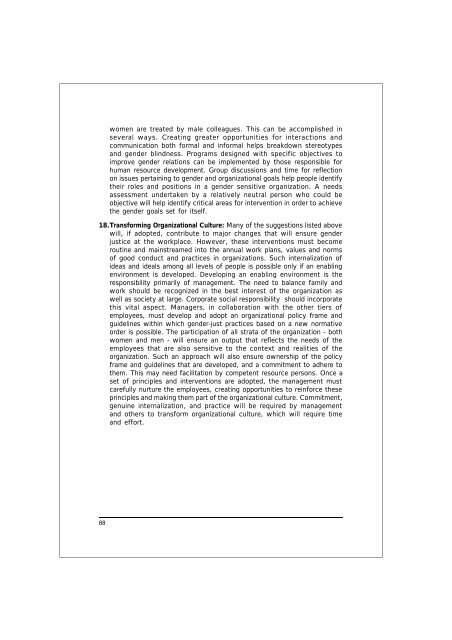Beyond Glass Ceilings and Brick Walls - International Labour ...
Beyond Glass Ceilings and Brick Walls - International Labour ...
Beyond Glass Ceilings and Brick Walls - International Labour ...
You also want an ePaper? Increase the reach of your titles
YUMPU automatically turns print PDFs into web optimized ePapers that Google loves.
women are treated by male colleagues. This can be accomplished in<br />
several ways. Creating greater opportunities for interactions <strong>and</strong><br />
communication both formal <strong>and</strong> informal helps breakdown stereotypes<br />
<strong>and</strong> gender blindness. Programs designed with specific objectives to<br />
improve gender relations can be implemented by those responsible for<br />
human resource development. Group discussions <strong>and</strong> time for reflection<br />
on issues pertaining to gender <strong>and</strong> organizational goals help people identify<br />
their roles <strong>and</strong> positions in a gender sensitive organization. A needs<br />
assessment undertaken by a relatively neutral person who could be<br />
objective will help identify critical areas for intervention in order to achieve<br />
the gender goals set for itself.<br />
18.Transforming Organizational Culture: Many of the suggestions listed above<br />
will, if adopted, contribute to major changes that will ensure gender<br />
justice at the workplace. However, these interventions must become<br />
routine <strong>and</strong> mainstreamed into the annual work plans, values <strong>and</strong> norms<br />
of good conduct <strong>and</strong> practices in organizations. Such internalization of<br />
ideas <strong>and</strong> ideals among all levels of people is possible only if an enabling<br />
environment is developed. Developing an enabling environment is the<br />
responsibility primarily of management. The need to balance family <strong>and</strong><br />
work should be recognized in the best interest of the organization as<br />
well as society at large. Corporate social responsibility should incorporate<br />
this vital aspect. Managers, in collaboration with the other tiers of<br />
employees, must develop <strong>and</strong> adopt an organizational policy frame <strong>and</strong><br />
guidelines within which gender-just practices based on a new normative<br />
order is possible. The participation of all strata of the organization - both<br />
women <strong>and</strong> men - will ensure an output that reflects the needs of the<br />
employees that are also sensitive to the context <strong>and</strong> realities of the<br />
organization. Such an approach will also ensure ownership of the policy<br />
frame <strong>and</strong> guidelines that are developed, <strong>and</strong> a commitment to adhere to<br />
them. This may need facilitation by competent resource persons. Once a<br />
set of principles <strong>and</strong> interventions are adopted, the management must<br />
carefully nurture the employees, creating opportunities to reinforce these<br />
principles <strong>and</strong> making them part of the organizational culture. Commitment,<br />
genuine internalization, <strong>and</strong> practice will be required by management<br />
<strong>and</strong> others to transform organizational culture, which will require time<br />
<strong>and</strong> effort.<br />
88
















